The past decade in the United States has seen technological advancements, demographic shifts and major changes in public opinion. Pew Research Center has tracked these developments through surveys, demographic analyses and other research. As the 2010s draw to a close, here are key ways the country looks different from 10 years ago:
From smartphones to social media, tech use has become the norm. As of 2019, nine-in-ten U.S. adults say they go online, 81% say they own a smartphone and 72% say they use social media. Growth in adoption of some technologies has slowed in recent years, in some instances because there just aren’t many non-users left, especially among younger generations. For example, 93% of Millennials (ages 23 to 38 in 2019) own smartphones, and nearly 100% say they use the internet.
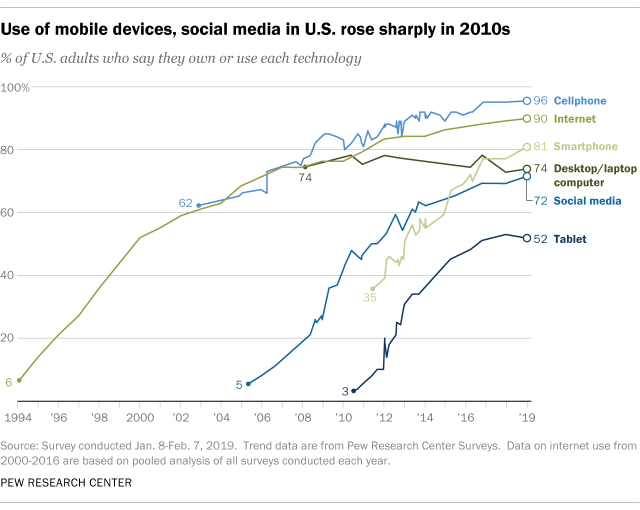
Social media is now a key pathway to news for Americans. In 2018, for the first time, social media sites surpassed print newspapers as a news source for Americans. One-in-five adults said they often get news from social media, slightly higher than the share who often did so from print newspapers (16%). Among social media sites, Facebook dominates in terms of news consumption: Around half of all U.S. adults (52%) now say they get news there.
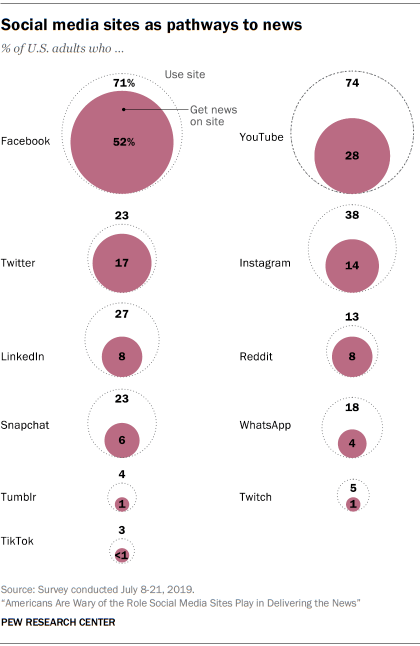
Millennials have surpassed Generation Xers as the largest generation in the U.S. labor force. There were 57 million Millennials (born 1981 to 1996) working or looking for work in 2018. That was more than the 53 million Gen Xers (born 1965 to 1980) and well ahead of the 38 million Baby Boomers (born 1946 to 1964).
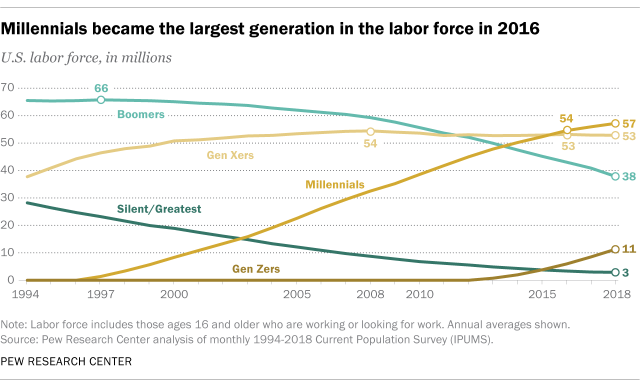
Following the Great Recession, the U.S. unemployment rate declined from a near record high level (9.5%) in the second quarter of 2010 to a near-record low (3.5%) in the second quarter of 2019 (figures are non-seasonally adjusted). Despite the downward trend in unemployment, the recovery in other labor market indicators has been anemic to absent in the post-Great Recession era. For example, the U.S. employment rate in 2019 is several percentage points lower than it was at the start of the Great Recession in 2007, primarily because of the aging U.S. population.
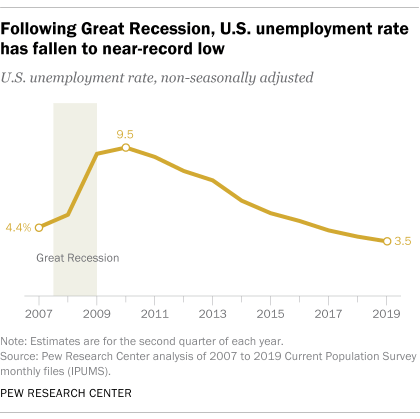
The 2010s will likely be the first decade in at least 160 years to see an increase in the average number of people living in U.S. households. This is in part because of the rising number of Americans living in multigenerational households. In 2016, a record 64 million people, or 20% of the U.S. population, lived with multiple generations under one roof, even with improvements in the U.S. economy since the Great Recession. Another factor behind the increase in household size: More Americans are “doubled up” in shared living quarters.
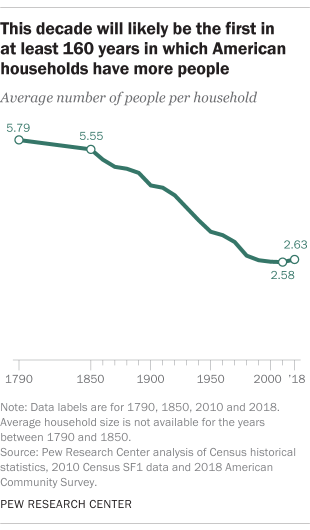
Nonwhites now account for the majority of the nation’s newborns, as well as the majority of K-12 students in public schools. More than half of newborn babies in the U.S. are racial or ethnic minorities, a threshold first crossed in 2013. Nonwhite students also account for the majority of the nation’s K-12 public school students. As of fall 2018, children from racial and ethnic minority groups were projected to make up 52.9% of public K-12 students.
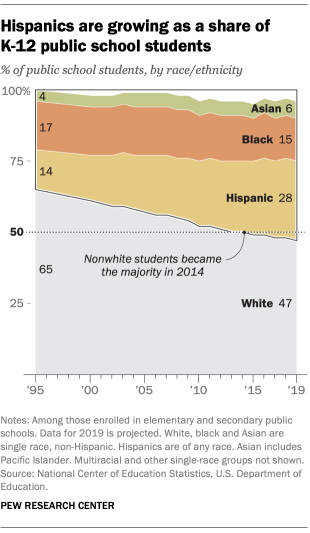
It’s become more common for Americans to attend church a few times a year or less (54%) than monthly or more (45%). This is just one measure by which the religious landscape of the country has changed. Since 2009, the share of Americans who describe their religious identity as atheist, agnostic or “nothing in particular” has grown from 17% to 26%, while the share who describe themselves as Christians has declined from 77% to 65%.
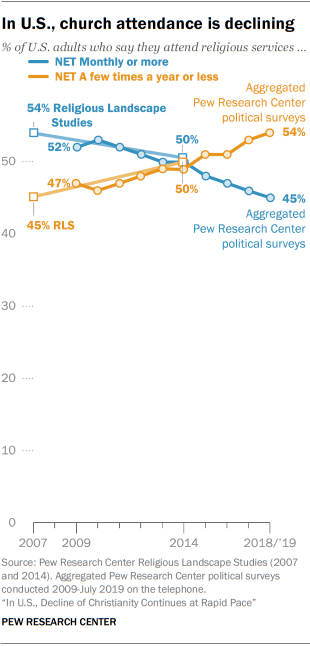
Americans increasingly support the legalization of marijuana. Two-thirds of U.S. adults now back legalization. A little less than a decade ago, in 2010, fewer than half (41%) did so. The change in public sentiment has been accompanied by a changing legal landscape: As of this year, 11 states and the District of Columbia have legalized small amounts of marijuana for adult recreational use, while many others have legalized it for medical use. The drug remains illegal under federal law.
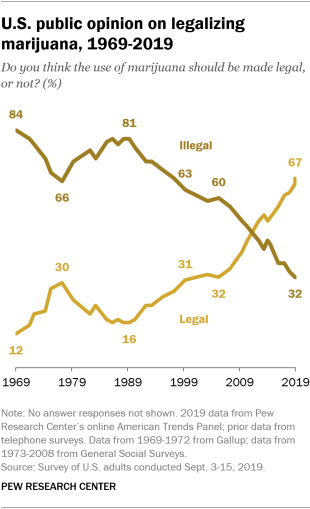
Same-sex marriage has the backing of a majority of U.S. adults. Same-sex marriage is another policy area where support surpassed opposition during the 2010s. As of this year, 61% of Americans favor allowing gays and lesbians to marry legally. In 2015, the U.S. Supreme Court issued its landmark Obergefell v. Hodges ruling, which established that same-sex couples have a constitutional right to marry.
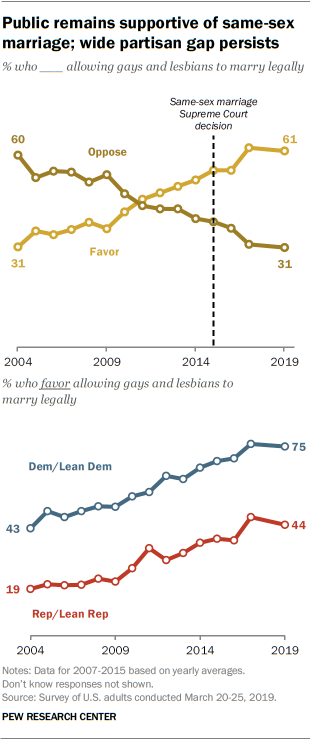
Note: This post contains updated data on the use of smartphones and other technologies, as well as the generational makeup of the U.S. labor force.
